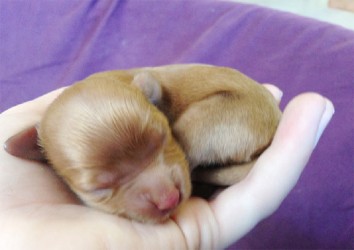Continued from last week
Puppy septicaemia (blood poisoning)
Last week, I mentioned that as a sequel to a navel infection, a septicaemia could develop. The germs enter the navel area and, if nothing is done about it, can spread throughout the puppy via the blood circulation. Puppies between four and 40 days seem to be most susceptible.
However, the more common entry point of germs is via the mouth and from there to the alimentary canal. In other words, the germs, which could later cause a general infection, enter the mouth – even while the pup is nursing from its mother. It is true that this milk (especially the milk produced during the first few days after giving birth) is rich in defence chemicals (antibodies) which protect the pup and give it immunity from those diseases which the mother dog had encountered during her life. But just as these immunity-giving chemicals in the milk can be absorbed by the membranes coating the pup’s intestines, so too can germs, entering the stomach and the bowels, penetrate into the bloodstream. Infected mother’s milk is a major cause of puppy septicaemia.
 Once these germs are in the bloodstream, they spread rapidly. The movement of the germs into the blood circulation goes through the intestines, and the symptoms are mainly located in the abdominal cavity. Since the infected milk is the main cause of the septicaemia, the symptoms at first will resemble those I described during the discussion on the Toxic Milk Syndrome (November 24). The puppy appears distressed and cries continuously, with saliva coming from the mouth (drooling).
Once these germs are in the bloodstream, they spread rapidly. The movement of the germs into the blood circulation goes through the intestines, and the symptoms are mainly located in the abdominal cavity. Since the infected milk is the main cause of the septicaemia, the symptoms at first will resemble those I described during the discussion on the Toxic Milk Syndrome (November 24). The puppy appears distressed and cries continuously, with saliva coming from the mouth (drooling).
Bloating and diarrhoea are the most obvious symptoms. The bloat comes from the gas being produced by the germs in the infected milk. The more gas produced, the more swollen the abdomen becomes and the more rigid and hard to the touch. Of course, all that gas in the abdomen pushes against the diaphragm thus compromising the latter’s movement, which in turn reduces the diaphragm’s ability to assist in the breathing. The pup is not getting to breathe out the waste gas (carbon dioxide) and is stymied in its ability to suck in fresh oxygen. The skin of the puppy takes on a dark red or bluish tint (very indicative of carbon dioxide accumulation in the tissues).
At this stage, the young pup is absolutely uncomfortable, dehydrated, exhibiting symptoms of pain and inappetence (loss of appetite), Since the pup is not eating, he loses weight. So you have a skinny pup with a greatly distended abdomen. If he does not see the vet, he will surely die. In fact, when things have reached this stage, I am not so sure that even the vet can help. But he/she might get the bad name when the pup finally succumbs, even though it was you (the owner) who should have brought the pup in as soon as the first symptoms exhibited themselves. So many pet owners think the problem will go away on its own; some owners even decide they will introduce their own therapy – not seldomly on the advice of a well-meaning friend or neighbour, who is equally non-knowledgeable.
Treatment
 In addition to placing the focus on the infection, you (and your vet) will have to tackle the symptoms. The dehydration has to be addressed.This means that the animal must be rehydrated with fluids (young coconut water, oral rehydration salts, drip administered by the vet etc). The diarrhoea has to be stopped. If only one pup is infected, remove it from the litter (keep an eye on the other puppies) and hand-rear it (see columns of October 27 and November 17). Your vet will decide and advise on the course of an antibiotic treatment, if such is at all necessary.
In addition to placing the focus on the infection, you (and your vet) will have to tackle the symptoms. The dehydration has to be addressed.This means that the animal must be rehydrated with fluids (young coconut water, oral rehydration salts, drip administered by the vet etc). The diarrhoea has to be stopped. If only one pup is infected, remove it from the litter (keep an eye on the other puppies) and hand-rear it (see columns of October 27 and November 17). Your vet will decide and advise on the course of an antibiotic treatment, if such is at all necessary.
Another aside
The savage murder of pit bulls recently
The Kaieteur News of Monday, November 25 reported that the spouse of a pit bull breeder was attacked by two of his dogs which had escaped from their kennels. Later, I was alerted that a video was being shown on the social network youtube as well as facebook, locally and internationally.
The human barbarity exhibited on the computer screen is not for the faint of heart. The video shows a group of citizens, having viciously slaughtered the two pit bulls which mauled the woman, turning their attention to innocent dogs (in their kennels) and proceeding to lambaste them with 2×4 pieces of wood and then chop them up, and later beheaded the dogs with great exhibitions of accomplishment. The plaintive cries and howls of pain from the defenceless dogs – mind you, they were in their respective kennels – did not evoke pity or compassion, instead the dogs’ expressions of agony seemed to excite the savage cruelty of the lynch mob.
I will not comment today on the supposed inherent viciousness of the pit bull breed, but I can confirm that the wicked human activities directed at this breed (not lastly by the owners/caregivers), the tormenting to make them angry, the confinement in small cages for days, the electric prods, the baiting will surely create a psychopathic dog, irrespective of breed.
I have been advised that there are paragraphs in the Animal Health Act that can be used to prohibit the cruelty to animals. In addition, chapter 8:02 of the Cruelty to Animals Act demonstrates clearly the illegality of the acts of those who murdered the innocent dogs. The authorities know who they are. The authorities must use the full extent of the law against them.
Pit Bull fighting must cease. It is simply inhumane and uncivilized behaviour.
Please implement disease preventative measures (vaccinations, routine dewormings, monthly anti-heartworm medication, etc) and adopt-a-pet from the GSPCA’s Animal Clinic and Shelter at Robb Street and Orange Walk, if you have the wherewithal to care well for the animals. Do not stray your unwanted pets, take them to the GSPCA’s Clinic and Shelter instead. If you do not wish your pet to have puppies or kittens, you may exploit the GSPCA’s free spay and neutering programme. If you see anyone being cruel to an animal, or if you need any technical information, please get in touch with the Clinic and Shelter by calling 226-4237.








